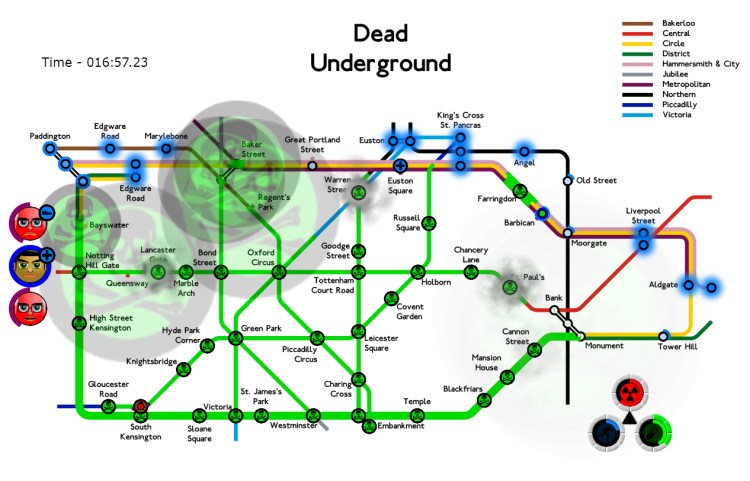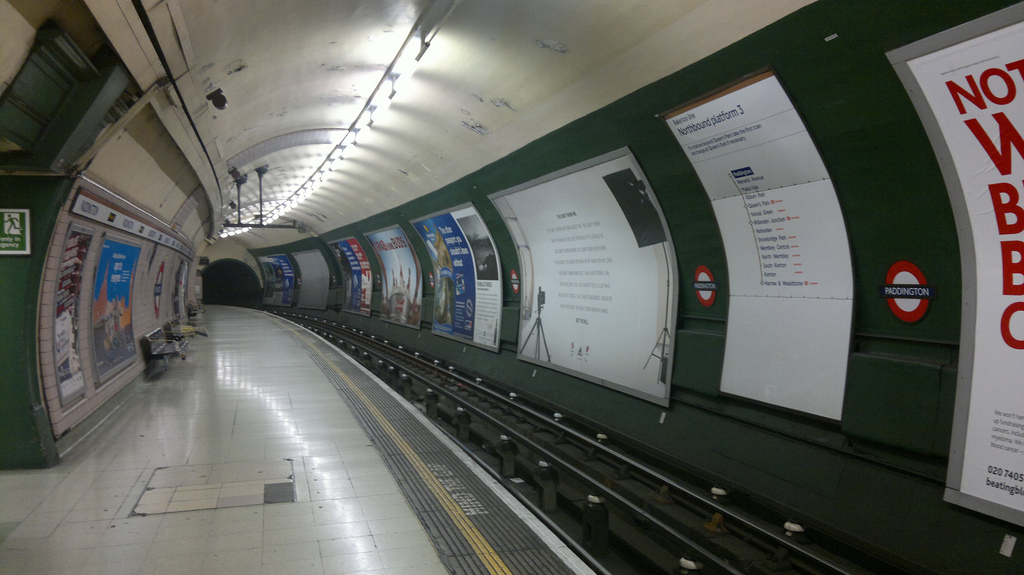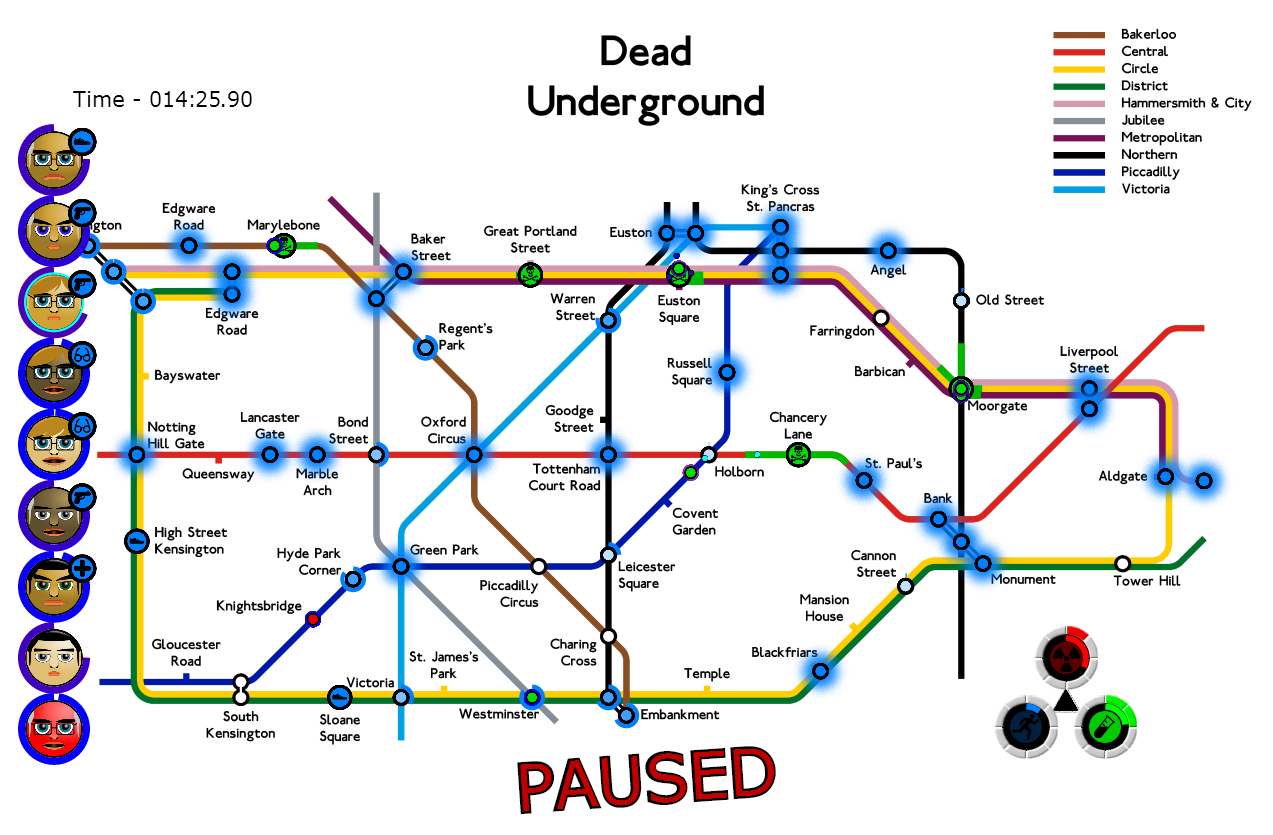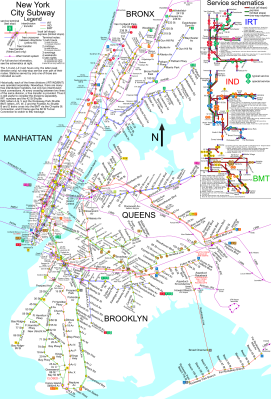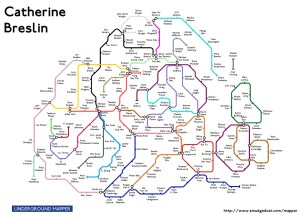Only four of us are left. We’re hunkered down at Tottenham Court Road — the last secure subway station in London. The streets aren’t safe anymore; we came down here as a last resort. Our only hope is to survive long enough to find a cure for this disease that has choked the life from the city.
The closed-circuit TV system is our friend, revealing which stations are clear and which the undead have infiltrated. Together, we must try to hole up as much of the underground as we can, helping fellow survivors we catch sight of, collecting weapons, researching this cure, and constantly driving back the damned undead souls that would tear us apart.
Welcome to Dead Underground, a free browser game that packs a movie’s worth of tension into a zombie-strategy experience that you can play at your desk in 10 minutes. You can play Dead Underground directly in your browser by going here.
The entire game centers around the London subway map (or tube as they call it over the pond) and a few simple icons, with its biggest graphical concession a hard-earned Napalm blast that can clear multiple stations of the zombie menace. Despite this, it creates a sense of urgency and impending doom as the undead hordes, represented by sickly green lines slowly spreading across the network, force you to juggle your limited human resources in the tunnels of the world’s oldest underground railway.
Surviving underground
You start Dead Underground with four survivors that you can move to any station by selecting them and right-clicking a destination, leaving them to wind their way through the tunnel network. Keeping a survivor at an empty station will reinforce it over time until it becomes a place of healing — and a location where zombies can no longer spawn. Choosing which stations to take is a key decision to make, as parts of the underground are better connected than others. Certain areas, such as the busy Circle and District line, have densely packed stations, which provide for quick player movement but also play host to potentially game-ending outbreaks.
Extra survivors spotted on CCTV appear on the map, providing a chance to rescue them and increase your human numbers. Likewise, you can collect guns, speed boosts, and healing abilities to improve your chances of survival. You also choose how best to invest your research time – focusing on ability boosts, napalm bombs, or the final cure.
At first, Dead Underground plays gently, allowing you to get your bearings. Pretty soon, though, zombies are dropping in all over the underground, demanding quick thinking and decisive action if you want to survive. Thankfully, there is an instant pause function that gives you time to breathe, take stock, and possibly make a nice cup of tea amid the carnage.
The map is the star
With the underground map itself being the star of the game, I wondered whether using its fixed lay-out had been a concern for independent developer David Johnston.
“I figured there were enough intersections between the different lines that balancing shouldn’t be too much of a problem,” Johnston told me via email. “Once the game was up and running, I was pleasantly surprised to find that different areas took on certain significance. The areas in the center of the map are normally easy to control because you will generally have a survivor somewhere close, but if you do let them get out of hand then the zombies can spread very quickly because they are very interconnected.”
“The stations with the most number of connections are found nearer the outside of the map,” Johnston said. “King’s Cross, Paddington, Liverpool Street, Embankment, and Bank/Monument — an outbreak [at any of these] normally requires a couple of survivors to keep things under control, so if one of those stations gets overrun, there’s normally a panic to keep it under control. I like the fact there are different areas like that in the map because it makes things more interesting. If the game was on a simple grid, I don’t think it would be anywhere near as much fun.”
Dead Underground takes place in the central area of the London Underground — Zone 1 – and excludes any station south of the River Thames. Johnston explained that as well as being the most recognizable section of the tube, it also offered a ring around the map (the Circle line) that survivors could move around. “I’d like to try a bigger map that took in more zones,” said Johnston, “but it might start to get a little difficult to see what’s going on as the map would have to get scaled down. Zone 1 feels like the right kind of size for the game.”
Is Dead NYC Subway on the way?
Dead Underground came about as a result of another project called Underground Mapper. Originally designed to show connections between assigned projects at a company he’d been working at, Johnston realized he could use his software to create a strategy game built into custom maps, with the London Underground being an obvious test subject.
With this in mind, I asked him if we’d see the undead infecting other international train networks soon, such as New York’s Subway. “I’d like to do some other underground systems,” said Johnston. “I had a look at the New York map but thought it looked like a bit of a mess, to be honest. The Paris Metro looks like it would be a good candidate, although possibly a bit tricky to decide what bits to include and what to leave out. There are many cities with an underground out there so there are plenty of maps to choose from!”
Facebook: The zombie survival game
While Dead Underground is a free browser title, Johnston offers players the chance to buy a bespoke version of the game based on their Facebook connections. “For a small fee [£5, or $8.41], I will generate a map in the style of the London Underground containing their Facebook friends,” said Johnston. “The software I use works out groups of people based on who everyone is friends with and assigns people to those lines. You might get one line which is friends you went to university with, another line might be family, and another work colleagues. The people I’ve done maps for so far have been really impressed by them because they capture their different social circles so well.“
Each of these maps becomes a fully playable game. “Some maps work better in Dead Underground than others, said Johnston. “It all depends how the map comes out. They’re all playable though and I try my best to group things so that it makes for an interesting game. A person’s partner is normally connected to several lines on their map so I try to make sure that’s somewhere near the middle and lines which don’t connect to anything are moved out nearer the edge.”
Johnston is happy to work with subjects other than Facebook connections as well, creating maps both large and small. “The key thing is that the speed of everything scales depending on the size of the map,” he said. “If a much bigger map than London Underground’s Zone 1 is created then the game would be too slow if everything moved at the same speed as in that map. In big maps like that everything is speeded up so it still moves at a reasonable pace. Equally, in a smaller map things are slowed down.”
If you want to save your Facebook friends from annihilation, then you can order a custom map from Johnston’s Underground Mapper site.
VentureBeat's mission is to be a digital town square for technical decision-makers to gain knowledge about transformative enterprise technology and transact. Learn More
